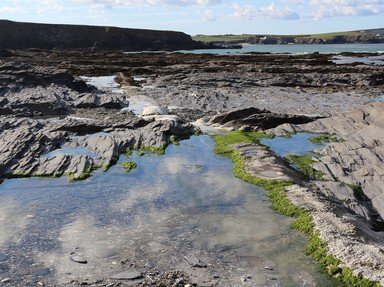Quiz Answer Key and Fun Facts
1. You waste no time in arriving on the beach, where you immediately come across a small scuttling isopod (order of crustaceans that includes the woodlouse), which is very common on the upper shore. What have you just found?
2. You spot a small chalk boulder which you promptly turn over. The underside of the rock seems to be dominated by jumping amphipods (order of small, shrimp-like crustaceans) desperately trying to get to a more sheltered area. What have you just found in abundance?
3. Into the rockpools you go, and already you see a small green crustacean scuttle across the bottom of the pool and navigate itself into a rock crevice. What have you just disturbed?
4. You continue to explore a rather large rockpool on the upper shore, and a moving whelk shell catches your eye. You reach down and pick it up out of the pool, and find that it is a hermit crab occupying the shell. There are many different species of hermit crab in Britain, but which is the most common?
5. You seem to have an eagle eye for rockpooling! You make out a large fish-like shape in the sand, and as your eyes get used to the camouflaged fish, you notice the large spines on its dorsal fin and head - best not pick this one up! What have you just found?
6. You continue to explore the upper shore, and after turning over another rock, you see a dozen or so shells all clustered together. Unlike the whelk shell you saw the hermit crab occupy, these shells lack a spire and appear to be much rounder. Which mollusc is this?
7. Underneath the same rock, your eyes are drawn to an echinoderm with five-part radial symmetry. It is yellow/orange in colour and is about 6cm across. What have you just found?
8. It's a hot day in summer, and you come across a very large rockpool that you're going to have to navigate past, as it is too deep to cross safely. As you are walking around the large pool, you see a large shoal of small fish swimming in the water. What is this fish likely to be?
9. You begin to move on to the middle shore, and underneath a stone you see a large crab, partially buried in the sand. The crab is a reddish/pink colour and has a wide carapace with a 'pie crust' edge. What species is this crab most likely to be?
10. Continuing on the middle shore, you turn over a small rock, and two piercing red eyes greet you, and sharp claws immediately snap at your fingers. You recoil back, understandably startled by this angry looking crab. What is it likely to be?
11. Bladder wrack, a species of brown algae, is an excellent way of identifying that you are on the middle shore, as it is very abundant in that zone. If you see serrated or toothed wrack, which area of the shore are you most likely to be on?
12. You are now on the lower shore, and you eagerly peer into a rockpool hoping to see another marine organism. Two red antennae underneath a rocky overhang catch your eye. You try to get closer, and manage to make out two predominantly blue claws, before the mystery crustacean retreats back under the overhang. What have you just seen?
13. As you make your way to the next large rockpool, you notice a very large fish in a very small pool. It seems to be guarding eggs! The fish is red in colour, with a deep, chunky body. It seems to be content in staying in the small rockpool. What is this fish?
14. You are understandably amazed to see such a big fish guarding eggs in such a small rockpool. That's dedication for you! Keeping on the lumpsucker theme, is it true that lumpsucker eggs are sold commercially as caviar?
15. You look at your watch and realise that it is ten minutes past low tide. Is it safe to stay out on the lower shore much longer?
Source: Author
Benesesso
This quiz was reviewed by FunTrivia editor
crisw before going online.
Any errors found in FunTrivia content are routinely corrected through our feedback system.

